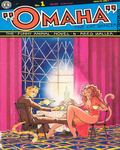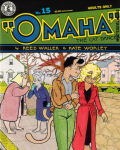Omaha the Cat Dancer

OMAHA THE CAT DANCER
Kitchen Sink (1986-95)
All 26 original issues: v01 19 issues • v02 4 issues • images of omaha 2 issues.
Every page scanned, including story pages, posters, puzzles, full color outer covers and inner cover glossy b&ws.
Omaha made her first less-than-prominent appearance in 1978, in the Vootie contribution of cartoonist Reed Waller. Vootie was an amateur press association devoted to funny animals, or furries, or even anthropomorphics, as many fans, perhaps sensitive about their affinity for such a child-associated genre, prefer to call them. An amateur press association puts out a collection of separately-published fanzines, distributed mainly among its members. This one was named after a sound made by an early Mad parody of J. Fred Muggs, a chimpanzee who appeared on the 1950s Today show, and probably the closest real life has to a funny animal.
She didn’t appear in a venue intended for general circulation until 1981, when Kitchen Sink Press (Megaton Man, The Spirit) devoted the 9th issue of its comix anthology Bizarre Sex, to her. She also turned up in the following issue, then in E-Man #5, where she starred in a faux Hostess Twinkies ad.
SteelDragon Press (Ant Boy, Captain Confederacy) first put Omaha in her own title in 1984. In SteelDragon’s second issue (1986), Kate Worley came in as scripter. But after that second issue, Omaha was back at Kitchen Sink. In October, 1986, Kitchen Sink reprinted SteelDragon’s two issues and added a third. With Worley helping to keep it on schedule, Kitchen Sink published a total of 20 issues by June, 1994. There were a few gaps but, especially in the early years, they mostly came out every two or three months. Fantagraphics (Usagi Yojimbo, Dalgoda) was Omaha’s next publisher. They published four issues between July, 1994 and February, 1995.
All this time, Worley, who wound up marrying Waller, carried Omaha’s storyline forward as a sexually explicit soap opera in funny animal drag, whatever category its many fans may say its characters belong to. It started out as a simple comment on the restrictive laws of Minneapolis, where Waller lives, regarding establishments like the one Omaha danced in. She had a boyfriend, Charles Tabey Jr., alias Chuck Katt, the scion of Charles Tabey Sr.’s financial empire, a large factor in the affairs of Mipple City, the version of Minneapolis where the action took place.
Contrary to many prior fictional treatments of sex workers, Omaha wasn’t a miserable, uneducated, self-loathing loser who wasn’t good for anything else. She enjoyed her work, where her gender was no barrier to being treated as a human being, or whatever the funny animal version of employer and customer respect might be. She chose her occupation over a number of alternatives, because it offered personal independence as well as scope for self-expression and satisfaction in her work. As a woman, or whatever, living in satisfaction with the life choices she’d made, Omaha was widely regarded as a worthy feminist role model.
This was of little avail in many local jurisdictions, where the nudity and occasional on-panel sex led to frequent charges of obscenity. Once, the comic was even accused of promoting bestiality, because some of the characters didn’t look entirely human, a charge that was ultimately laughed out of court. On the other hand, a New Zealand authority, ruling on whether or not the comics could be imported to that country, said its sensitive depiction of realistic character relations made it suitable for all ages.
But personal factors on the part of her creators made Omaha’s publishing history less than 100% smooth. Chief among them were marital problems between Waller and Worley, but accidents and other medical problems also played a part — ultimately, the most important part of all, as Worley’s 2004 death from cancer put an end to the couple’s efforts to work past their differences far enough to bring Omaha’s storyline (which hadn’t been advanced with new material since 1995) to a satisfactory conclusion before going their separate ways.
Meanwhile, the first effort to bring Omaha out in book form was made back in the Kitchen Sink days. Five volumes of The Collected Omaha were released between 1987 and 1993. They were kept in print by Fantagraphics. But the collected versions lacked much early material, particularly what appeared in Vootie.
In 2005, NBM (Tarzan, Terry & the Pirates) started publishing The Complete Omaha. NBM’s Sizzle magazine is serializing the rest of story, using scripts by Jim Vance, working from Worley’s notes and sketches, to complete the story. The Sizzle material will be reprinted in the final volume, finally bringing the series to its conclusion.



























